 |
| Op Art Animation courtesy http://www.op-art.co.uk/ Before reading this post, click here for a list of resources and supplies (and where you can buy them) to get you started creating your own wonderful rhythmic line drawings. Rhythmic designs are formed any time a line is repeated to form a pattern. Rhythmic patterns can be seen all around us, from the veins in a leaf to the curling waves of the ocean to the whorls of your finger prints. They're even in the pattern on the bottom of your sneakers! |
While planning this unit, I experimented with all the ways I could think of to use black and white rhythmic lines. I took photographs wherever I found linear patterns and looked at how artists throughout history used rhythmic line to create dynamic art. Each piece I saw inspired me to experiment, create and develop my ideas. Hopefully this lesson will do the same for you.
Here is the sphere pattern I used in the above video:
Art Installation by Tony Oursler-Eyes from Rachel Wintemberg on Vimeo.
This art installation was created by the artist Tony Oursler.
Unlike other video artists, Oursler projects his images not on a uniform surface but on to dolls, balls, architecture and other surfaces such as treetops and clouds of steam. To learn more about this artist click here and here.
Here is the sphere pattern I used in the above video:
How can you transform a circle into a picture of a three dimensional form? If you simply add shadows, mid-tones and highlights, you will have a sphere.
Take it a step farther by experimenting with rhythmic line and pattern and you could transport your audience into the virtual world of your imagination.
Look at the world around you, including video games and movies, to get ideas for your drawings.
Art Installation by Tony Oursler-Eyes from Rachel Wintemberg on Vimeo.
This art installation was created by the artist Tony Oursler.
Unlike other video artists, Oursler projects his images not on a uniform surface but on to dolls, balls, architecture and other surfaces such as treetops and clouds of steam. To learn more about this artist click here and here.
Spheres are only the beginning! There is no limit to what you can create with line.
Below are some black pen doodles that I created while thinking about rhythmic lines in the last few days.
Below are some black pen doodles that I created while thinking about rhythmic lines in the last few days.
How about drawing a magical garden, densely packed with different types of rhythmic, repeating lines?
Above, are my experimental magical line gardens. Below are some vintage illustrations of Edgar Allan Poe stories by the artist Harry Clarke. How many different types of rhythmic lines, patterns and textures does he use? When he repeats a line pattern over and over, it gives his drawing unity. When he uses many different types of patterns, lines and textures, it gives his pictures variety. To learn more about this artist, click on the link below:
Assignment 2:
Photograph rhythmic line patterns in nature. You can use any camera, even a cell phone camera.
Look at leaves, flowers, ferns, sea shells and anything else you can think of.
Here are some of my photographs of natural forms with rhythmic line patterns.
Below are some commonly repeated Art Nouveau motifs that I found on the Internet using Google image search.
Assignment 6: After viewing Macarthur's work, draw a contour line picture of a bird, reptile or other animal. Use lines that follow the three dimensional form of the animal to divide your picture into distinct sections. This is very easy to do with birds or reptiles because they have different types of feathers or scales and distinct color patterns on different parts of their bodies. Your picture will look far more interesting if you draw your lines along these natural divisions. Remember, learning how to draw means learning how to see. A drawing that reflects insightful observation of nature will engage your viewers. Now fill in each section with a different type of rhythmic linear design.Continue to follow the three dimensional form of your animal to give your final piece a sense of volume.
Compare the zoomorphic (or animal) designs on the Native American Mimbres pottery to Iain Macarthur's work. Notice how three dimensional his pictures appear.
There is nothing wrong, in general, with filling an animal design with flat patterns. Indeed, artisans from the prehistoric Mimbres tribe of southern New Mexico did this so successfully that reproductions of their designs are still sold throughout the world today. But, for the purpose of this assignment, I would like my students to make a conscious effort to express three dimensional volume in their work.
In 1515 Albrecht Durer produced this fanciful woodcut. No one in Europe had ever seen an actual rhinoceros. Durer created this picture from a description he had read.
The drawings below were created by an artistic duo from Brazil. they call themselves

More Zen Doodle and tangle ideas
Basic Tangle instructions
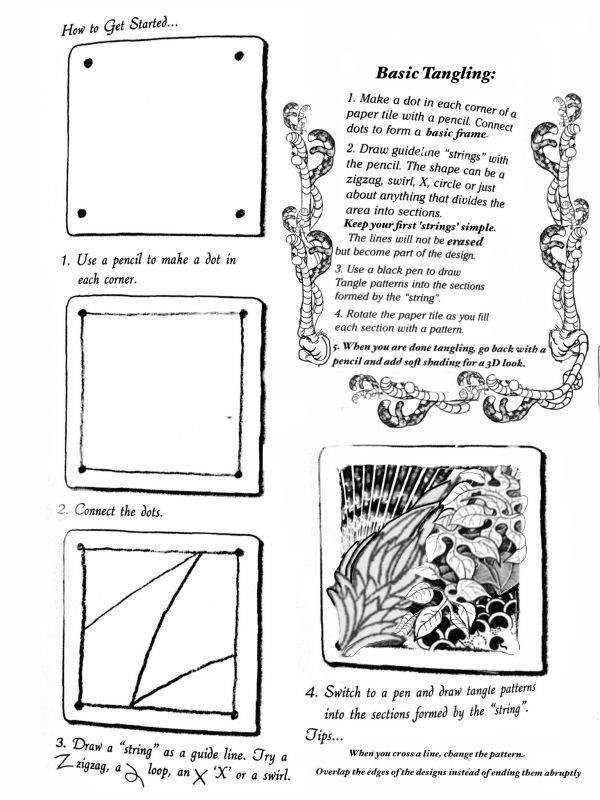
ZEN DOODLE PATTERN IDEA WORKSHEETS
I discovered these patterns in natural forms and created the worksheets from my own photographs. I discovered still more rhythmic patterns in the details of the artwork pictured above. Can you identify any of them?
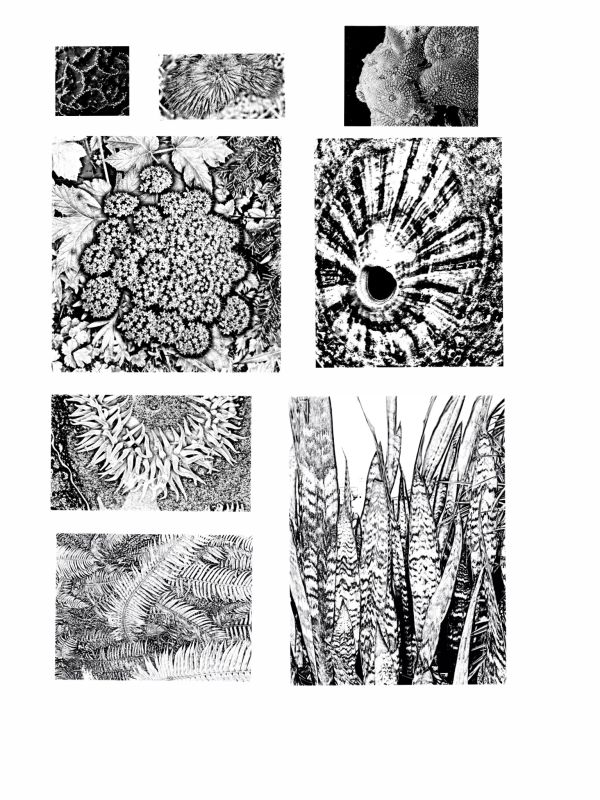
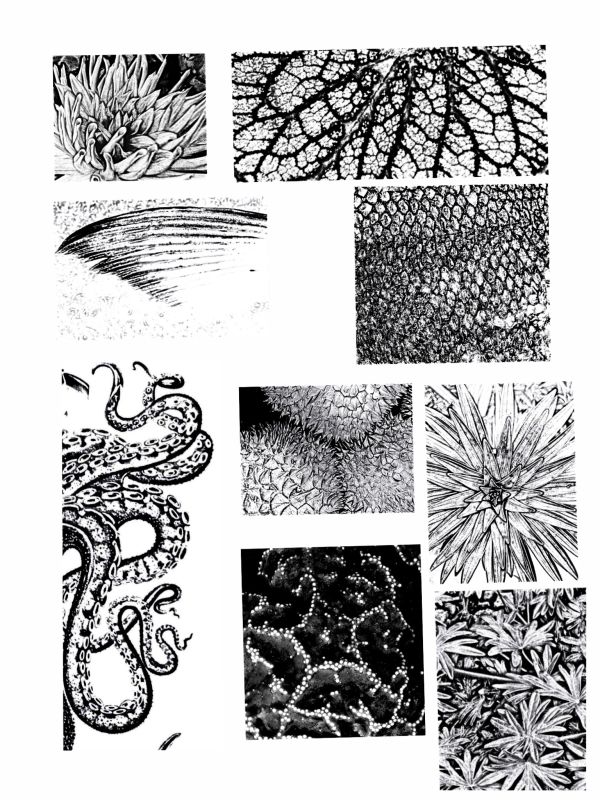
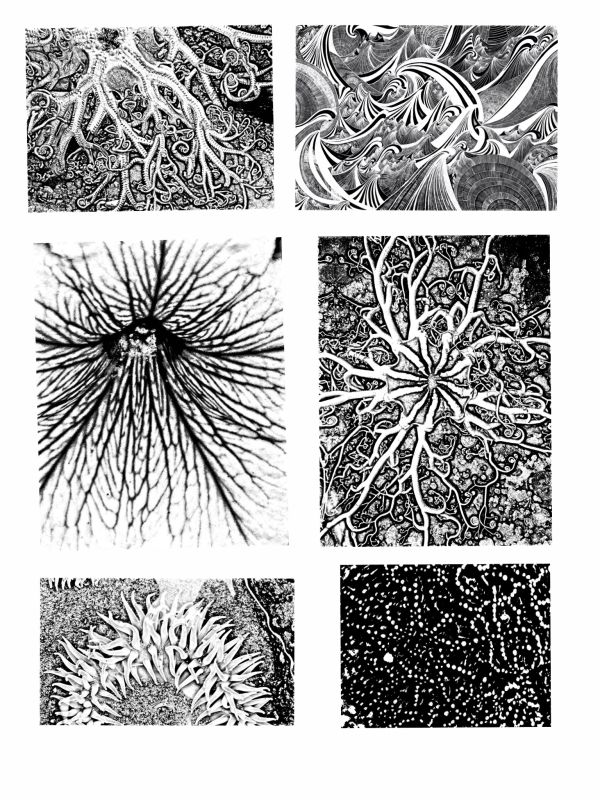
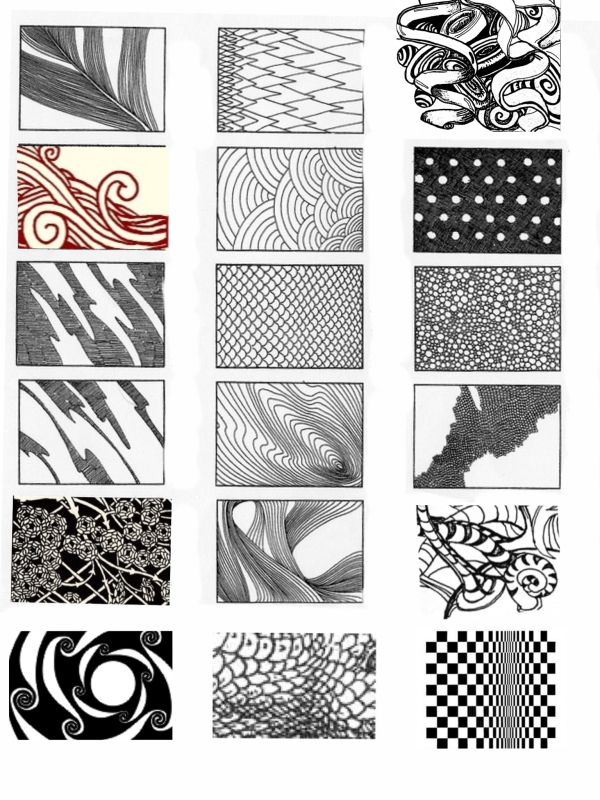
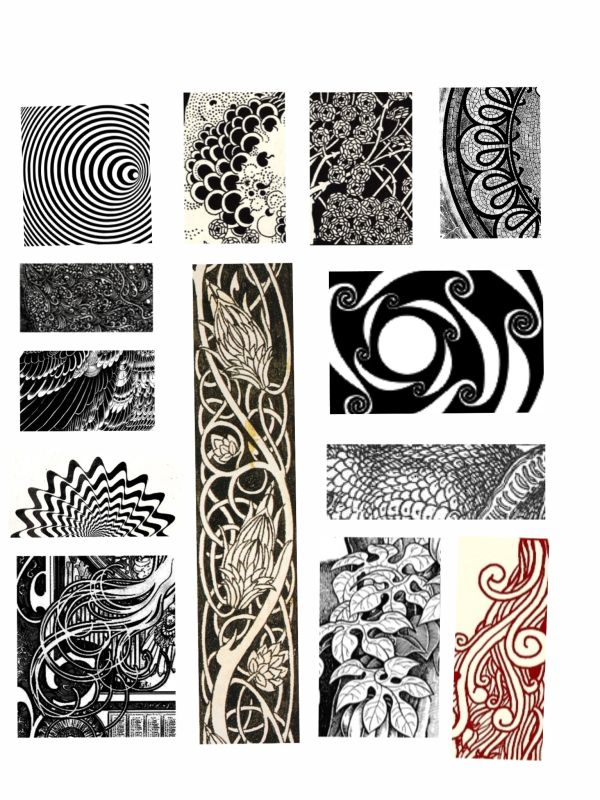
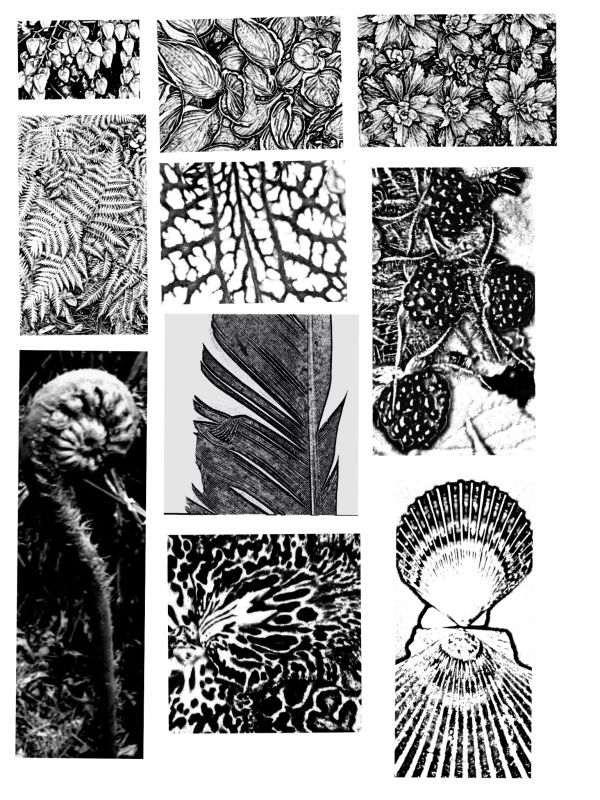
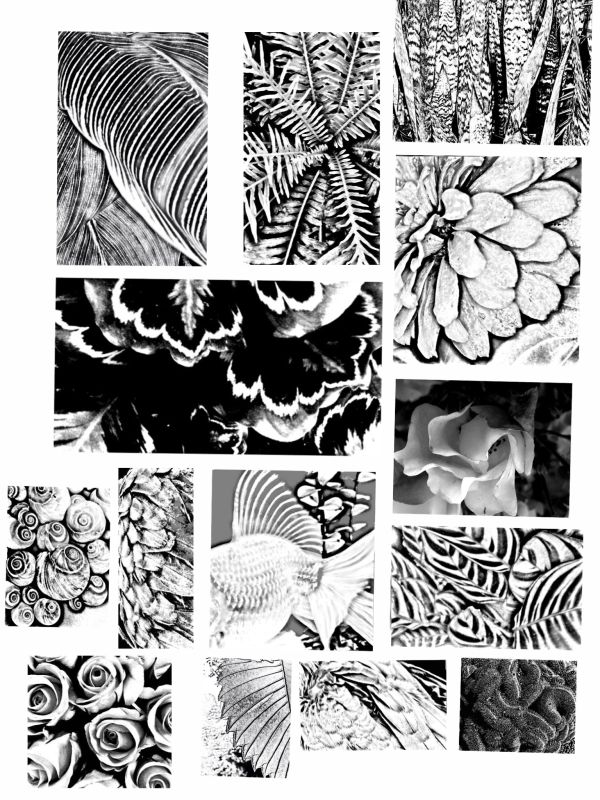
 |
| Photo credit: My husband, Tim Wintemberg. Eastern timber rattlesnake, New Paltz, NY |
Zoom in and crop off just a small section of each of your photographs to isolate the rhythmic patterns.
Assignment 3: Make a series of small sketches of the patterns you find using a sharpened pencil and a fine tipped graphic pen.
 |
| It may be easier to concentrate on the rhythmic line patterns if you print your reference images in black and white. |
Zebra Shells (Modified from a photograph by Sheri from www.facebook/Math-Explosion.com)
Assignment 4: Start creating your own rhythmic line doodles using the images you've been gathering to inspire you! Print out and refer to this rhythmic line poster and see if you can figure out what types of lines you are combining to create patterns.
Using a pencil, try shading in the edges of some of your shapes to give your patterns a three dimensional look.
Here is a doodle I created,
using organic forms as my inspiration.
Notice how I used curved lines that follow the arching three dimensional forms of the ribbons and spirals
to create shadows.
When you envision the shapes you have drawn as three dimensional forms you can create a much more engaging image, as this picture of two spheres clearly illustrates. Without the curved lines that define their form,
they would merely be flat circles.
 |
| Here is another doodle I created by combining different types of rhythmic lines... |
 |
| Here is another small doodle I created... |
 |
| ...and the design I created from it. Now that you have gathered inspiration from the world around you, it's time to take a look at what other artists have created. |
An excellent source of rhythmic line designs is South West Native American Pottery
Try zooming in and cropping sections of the images below
to isolate the rhythmic line patterns that Art Nouveau illustrators, graphic designers and artists used.
Poster designs by Alphonse Mucha
The black ink drawings below were created by the Art Nouveau graphic illustrator Aubrey Beardsley.
Click on each of Beardsley's pictures to view the enlarged version. Download the images, zoom in and crop to isolate the many rhythmic line designs
he used in each densely detailed illustration.
Use these designs as a reference
when you create your own patterns.
Please note: All Bridget Riley images are copyright protected. You may print them and use them for non commercial educational purposes only.
Bridget Riley is a founding member of the Op Art movement.
Here is a doodle I created after looking at Bridget Riley's work and the Art Nouveau designs above.
And here is the design I created by tiling
(repeating, rotating and flipping) my doodle
Contemporary artists who use rhythmic line designs and patterns
Assignment 6: After viewing Macarthur's work, draw a contour line picture of a bird, reptile or other animal. Use lines that follow the three dimensional form of the animal to divide your picture into distinct sections. This is very easy to do with birds or reptiles because they have different types of feathers or scales and distinct color patterns on different parts of their bodies. Your picture will look far more interesting if you draw your lines along these natural divisions. Remember, learning how to draw means learning how to see. A drawing that reflects insightful observation of nature will engage your viewers. Now fill in each section with a different type of rhythmic linear design.Continue to follow the three dimensional form of your animal to give your final piece a sense of volume.
Compare the zoomorphic (or animal) designs on the Native American Mimbres pottery to Iain Macarthur's work. Notice how three dimensional his pictures appear.
There is nothing wrong, in general, with filling an animal design with flat patterns. Indeed, artisans from the prehistoric Mimbres tribe of southern New Mexico did this so successfully that reproductions of their designs are still sold throughout the world today. But, for the purpose of this assignment, I would like my students to make a conscious effort to express three dimensional volume in their work.
In 1515 Albrecht Durer produced this fanciful woodcut. No one in Europe had ever seen an actual rhinoceros. Durer created this picture from a description he had read.
Rhinoceros by Albrecht Durer, 1515
To learn more about this famous woodcut, click here
Illustrations by Robert Crumb
for Kafka and the Book of Genesis.
Click to enlarge each drawing. Notice how Crumb uses rhythmic line in every detail of his work; to create light and shadow, to show texture, volume and movement and even to express mood.
for Kafka and the Book of Genesis.
Click to enlarge each drawing. Notice how Crumb uses rhythmic line in every detail of his work; to create light and shadow, to show texture, volume and movement and even to express mood.
Robert Crumb
The drawings below were created by an artistic duo from Brazil. they call themselves

Below is a video of this artistic duo at work
Detailed timelapse of a 5 day journey to complete the entrance hall at MIS (Museum of Image and Sound)
Zentangle
Zentangle is a form of design that uses a vocabulary of rhythmic line patterns to create small black and white designs on squares of paper.
Why is Zentangle useful to art students?
As you can see from the images above, each artist has a vocabulary of patterns that they repeat to create beautiful designs. The bigger your vocabulary of patterns, the more engaging your designs will be. The following Zentangle websites are a wonderful source of patterns and designs and a great source of inspiration.
More Zen Doodle and tangle ideas
Basic Tangle instructions

ZEN DOODLE PATTERN IDEA WORKSHEETS
I discovered these patterns in natural forms and created the worksheets from my own photographs. I discovered still more rhythmic patterns in the details of the artwork pictured above. Can you identify any of them?







 |
| Zentangle by one of my students |

Take a look at my original photograph, before I removed the color and zoomed in on the pattern. Can you still see the rhythmic lines?
Rhythmic linear designs can be found in all forms of art.
Below are photographs I took of some
contemporary sculpture and jewelry
Assignment 7: Now it's your turn to use rhythmic line design with three dimensional forms. I gave the assignment below to my 6th graders last year.
 |
| Rhythmic pattern by a 6th grade student |
 |
| Printable worksheet for this assignment |
Grading rubric
Artwork by 6th grade students hanging from the ceiling of my classroom. Great job kids!
Work in progress by bilingual 6th grade students:
Common Core Math Standards for this activity:
6.G.4 - Represent three-dimensional figures using nets made up of rectangles and triangles
More Op Art ideas
To see this worksheet in it's original colors, click here
Sketchbook Pro for iPad. Music added using iMovie for iPad. Draw, reflect, transform
Free Printable Worksheets From Line And Form by Walter Crane
Click on the link below to download this free ebook:
A final thought on rhythmic line design and pattern:
"Limitations live only in our minds. If we use our imaginations our possibilities become limitless."
-Adam Granet















































































































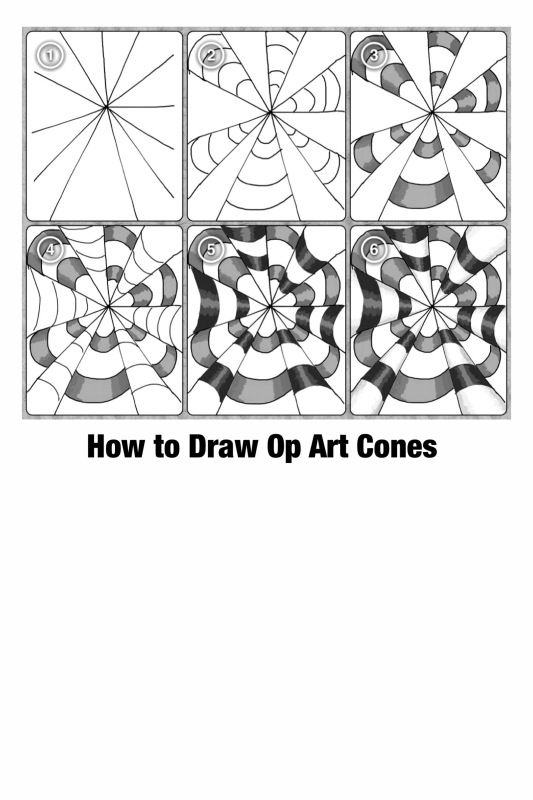



The bigger your vocabulary of patterns, the more engaging your designs will be.
ReplyDeleteThankyou for duch a yhorough job of putting these resources togethrr! How inspirational....and has given me some ideas to extend some of my year 8 students!
ReplyDeleteFantastic content very helpful fo beginner like myself just love the patterns and designs here. Cant wait to try some myself .
ReplyDelete